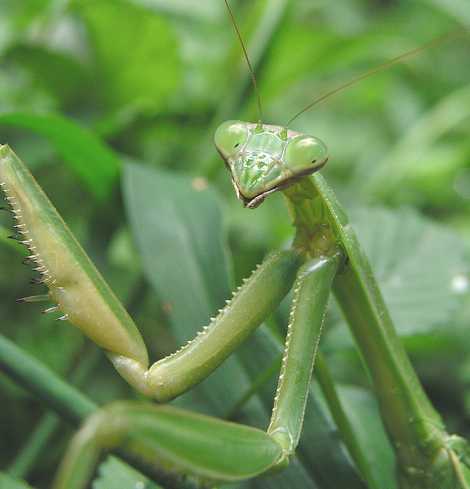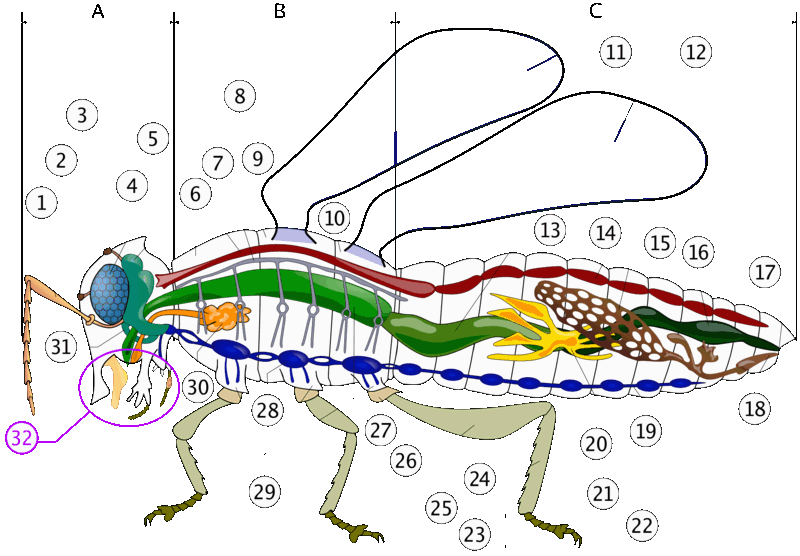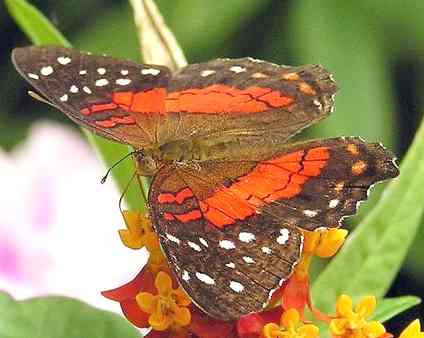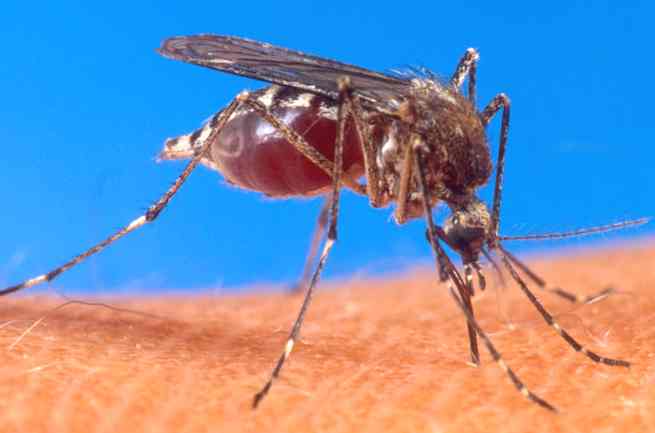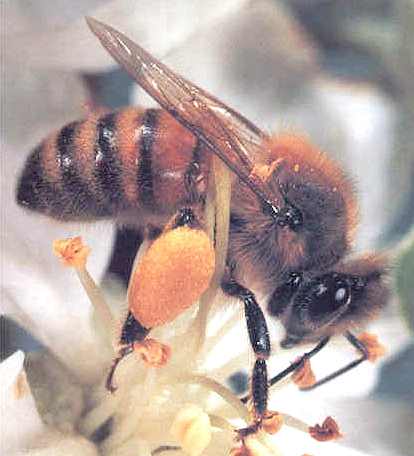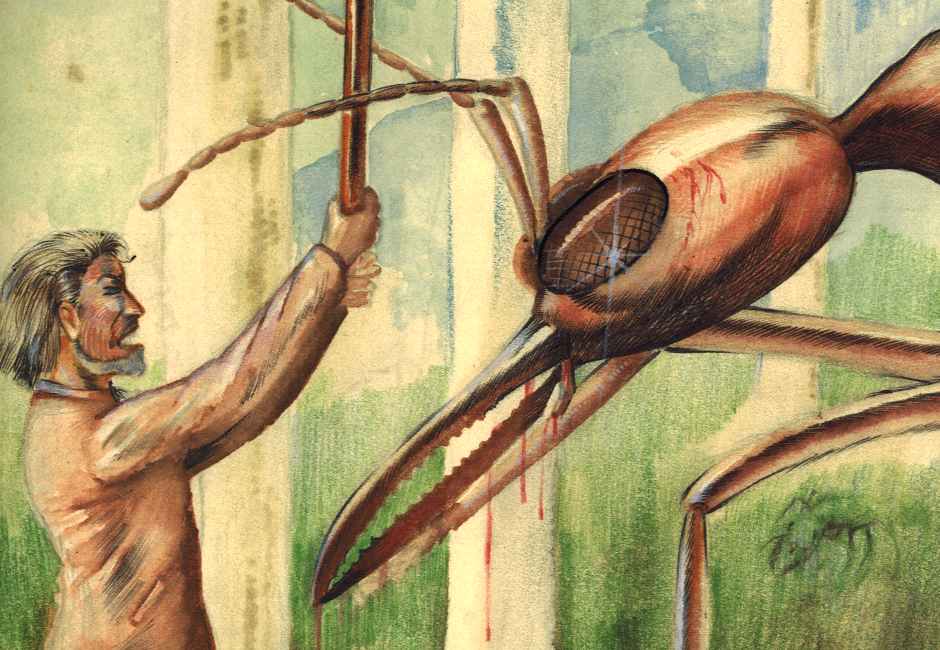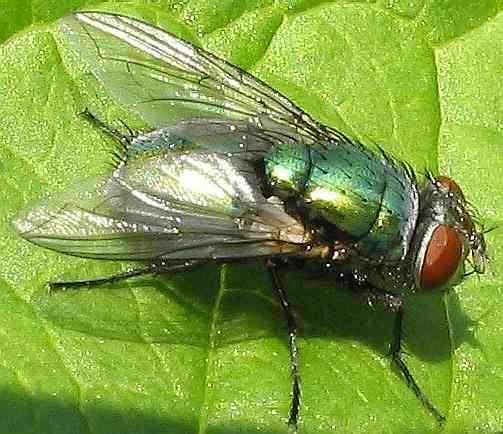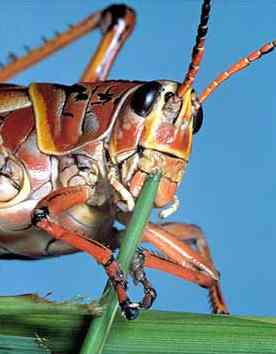|
INSECTS
|
||||||||||||||||||||||||||||||||||||||||||||||||||||
When I was a lad, I was fascinated by Ants. All that organised activity and the mounds of earth moved when making a nest. Later, I discovered large wood ants in a forest near London. Then later still while on holiday in Italy, I found some jet black ants with big heads.
Watch insects working they are amazing machines
As you can imagine, curiosity got the better of me, and I decided to keep a few ants to study them more closely. I collected a handful of wood ants (formica rufus), twigs and earth, put them in a large laboratory glass vacuum bowl and bingo, overnight they built a nest. The folks were not too pleased and my mates thought I was crazy, but what fun. Now, wood ants are quite dangerous. Their bite is deep, and worse, they either spray or inject you with formic acid - which really stings. (See the Ant page for more on this). Then when you look at other insects, you realise just how diversified and interesting they are. Some useful, most a nuisance.
Take the Water Boatman - a beetle that can dive underwater and fly. That's a bit like building a flying submarine - tricky! We had a swimming pool in our back garden when I was at school. Every summer after emptying it, about six inches of water would remain, which would become stagnant and then become the domain of these adaptable creatures. The only way in and out was to fly. At first I could not believe this, but then I saw it with my own eyes. Incredible as this may seem, almost every insect has such a fantastic story - never mind science fiction - get a load of this world.
DESCRIPTION
Insects are invertebrates that are taxonomically referred to as the class Insecta. They are the most numerous and most widespread terrestrial taxon within the phylum Arthropoda. Insects are the most diverse group of animals on the earth, with around 925,000 species described - more than all other animal groups combined. Insects may be found in nearly all environments on the planet, although only a small number of species have adapted to life in the oceans where crustaceans tend to predominate.
There are approximately 5,000 dragonfly species, 2,000 praying mantis, 20,000 grasshopper, 170,000 butterfly and moth, 120,000 fly, 82,000 true bug, 350,000 beetle, and 110,000 bee and ant species described to date. Estimates of the total number of current species, including those not yet known to science, range from two million to thirty million, with most authorities favoring a figure midway between these extremes. Adult modern insects range in size from 555 mm ( Phobaeticus serratipes) to 0.139 mm.
The study of insects (from Latin insect, meaning "cut into sections") is called entomology, from the Greek εντομος, also meaning "cut into sections".
Chinese praying mantis
Relationship to other arthropods
Other terrestrial arthropods, such as centipedes, millipedes, scorpions and spiders, are sometimes confused with insects due to the fact that both have similar body plans, sharing (as do all arthropods) a jointed exoskeleton. However these do not have the important feature of having six legs.
Within the subphylum Hexapoda, a few groups such as springtails (Collembola), are often treated as insects; however some authors treat them as distinct from the insects in having a different evolutionary origin. This may also be that case for the rest of the members of the Entognatha; Protura and Diplura.
The true insects, those of the Class Insecta, are distinguished from all other arthropods in part by having ectognathous, or exposed, mouthparts and eleven (11) abdominal segments. The true insects are therefore sometimes also referred to as the Ectognatha. Many insect groups are winged as adults. The exopterygote part of the Neoptera are sometimes divided into Orthopteroida (cerci present) and Hemipteroida (cerci absent), also called lower and higher Exopterygota.
Morphology and development
1.
antenna
Insect anatomy: A- Head B- Thorax C- Abdomen
Insects range in size from less than a millimeter to over 18 centimeters (some walkingsticks) in length. Insects possess segmented bodies supported by an exoskeleton, a hard outer covering made mostly of chitin. The body is divided into a head, a thorax, and an abdomen. The head supports a pair of sensory antennae, a pair of compound eyes, and mouth parts. The thorax has six legs (one pair per segment) and wings (if present in the species). The abdomen (made up of eleven segments some of which may be reduced or fused) has respiratory, excretory and reproductive structures.
Their nervous system can be divided into a brain and a ventral nerve cord. The head capsule (made up of six fused segments) has six pairs of ganglia. The first three pairs are fused into the brain, while the three following pairs are fused into a structure called the subesophageal ganglion.
The thoracic segments have one ganglion on each side, which are connected into a pair, one pair per segment. This arrangement is also seen in the abdomen but only in the first eight segments. Many species of insects have reduced numbers of ganglia due to fusion or reduction. Some cockroaches have just six ganglia in the abdomen, whereas the wasp Vespa crabro has only two in the thorax and three in the abdomen. And some like the house fly Musca domestica have fused all the body ganglia into a single large thoracic ganglion.
Insects have a complete digestive system. That is, their digestive system consists basically of a tube that runs from mouth to anus, contrasting with the incomplete digestive systems found in many simpler invertebrates. The excretory system consists of Malpighian tubules for the removal of nitrogenous wastes and the hindgut for osmoregulation. At the end of the hindgut, insects are able to reabsorb water along with potassium and sodium ions. Therefore, insects don't usually excrete water with their feces, allowing storage of water in the body. This process of reabsorption enables them to withstand hot, dry environments.
Most insects have two pairs of wings located on the second and third thoracic segments. Insects are the only invertebrates to have developed flight, and this has played an important part in their success. The winged insects, and their wingless relatives, make up the subclass Pterygota. Insect flight is not very well understood, relying heavily on turbulent aerodynamic effects. The primitive insect groups use muscles that act directly on the wing structure. The more advanced groups making up the Neoptera have foldable wings and their muscles act on the thorax wall and power the wings indirectly. These muscles are able to contract without nerve impulses allowing them to beat faster.
Their outer skeleton, the cuticle, is made up of two layers; the epicuticle which is a thin and waxy water resistant outer layer and contains no chitin, and another layer under it called the procuticle. This is chitinous and much thicker than the epicuticle and has two layers. The outer being the exocuticle while the inner is the endocuticle. The tough and flexible endocuticle is built from numerous layers of fibrous chitin and proteins, criss-crossing each others in a sandwich pattern, while the exocuticle is sclerotized.
Insects use tracheal respiration with openings on the sides of the thorax and abdomen called spiracles leading to the tubular tracheal system. Air reaches internal tissues via a network of branches from the tracheal system. There is usually one pair of spiracles per segment. There can be up to 8 abdominal segments with spiracles and upto 2 thoracic segments (restricted to the mesothorax and metathorax). Some groups have reduced numbers of spiracles with the hoverflies having none on their abdomen. There is a physical limit to the pressure that the walls of the tracheal tubes can withstand without collapsing, even though they are stiffened by bands of chitin, and this is one of the reasons why insects are relatively small. The spiracles have muscle controlled valves, enabling the insects to avoid drowning in water or to prevent desiccation. The spiracles often have hairs that help filter the air entering them.
Tarantula v wasp
Some insect groups such as the Chironomidae or "blood worms" have true respiratory pigments such as hemoglobin in their blood during their larval stage. Here the trachea are often reduced as their body can absorb oxygen directly from the water, allowing them to live in bottom mud where the oxygen levels are low.
In certain types of water bugs the three pairs of the spiracles are covered by a pressure-sensitive membrane that help them sense their position in water. The last abdominal spiracle and associated trachea of certain Lepidopteran caterpillars are modified into a tracheal lung adapted for hemocyte gas exchange. Short tracheoles from this trachea ends in knots within the tracheole cell basement membrane. Since they do not supply any cellular tissue, it seems most likely that they are supplying the hemocytes with oxygen.
The Madagascar hissing cockroach uses certain spiracles to forcibly expel air to create a loud hissing sound when threatened.
A diffuse tissue called a fat body is found in the abdominal haemocoel of some insects. This is believed to help in energy storage and metabolic processes and acts like a liver for the insects.
The circulatory system of insects, like that of other arthropods, is open: the heart, which is little more than a perforated muscular tube along the dorsal midline, pumps the hemolymph to open spaces surrounding the internal organs; when the heart relaxes, the hemolymph seeps back into the heart.
Like some other invertebrates, insects cannot synthesise cholesterol and must receive it from the diet. With very few exceptions, they also require long-chain fatty acids in their diet. Lack of these fatty acids affects their development leading to delayed maturity or deformations.
A butterfly is the adult stage of an insect with complete metamorphosis This species is Anartia amathea
Development
Most insects hatch from eggs, but others are ovoviviparous or viviparous, and all undergo a series of moults as they develop and grow in size. This manner of growth is necessitated by the inelastic exoskeleton. Moulting is a process by which the individual escapes the confines of the exoskeleton in order to increase in size, then grows a new and larger outer covering. In some insects, the young are called nymphs and are similar in form to the adults except that the wings are not developed until the adult stage. This is called incomplete metamorphosis and insects showing this are termed as Hemimetabolous. Holometabolous insects show Complete metamorphosis, which distinguishes the Endopterygota and includes many of the most successful insect groups. In these species, an egg hatches to produce a larva, which is generally worm-like in form, and can be divided into five different forms; eruciform (caterpillar-like), scarabaeiform (grublike), campodeiform (elongated, flattened, and active), elateriform (wireworm-like) and vermiform (maggot-like). The larva grows and eventually becomes a pupa, a stage sealed within a cocoon or chrysalis in some species. There are three types of pupae; obtect (the pupa is compact with the legs and other appendages enclosed), exarate (where the pupa has the legs and other appendages free and extended) and coarctate (where the pupa develops inside the larval skin). In the pupal stage, the insect undergoes considerable change in form to emerge as an adult, or imago. Butterflies are an example of an insect that undergoes complete metamorphosis. Some insects have even evolved hypermetamorphosis.
Some insects (parastic wasps) show polyembryony where a single fertilized egg can divide into many and in some cases thousands of separate embryos. Other developmental and reproductive variations include haplodiploidy, polymorphism, paedomorphosis (metathetely and prothetely), sexual dimorphism, parthenogenesis and more rarely hermaphroditism.
Behavior
Many insects possess very sensitive organs of perception. Some insects such as bees can see in the ultraviolet spectrum while male moths can detect the pheromones of female moths over distances of many kilometers.
Many insects also have a well-developed number sense, especially among the solitary wasps. The mother wasp lays her eggs in individual cells and provides each egg with a number of live caterpillars on which the young feed when hatched. Some species of wasp always provide five, others twelve, and others as high as twenty-four caterpillars per cell. The number of caterpillars is different among species, but it is always the same for each sex of eggs. The male solitary wasp in the genus Eumenes is smaller than the female, so the mother supplies him with only five caterpillars; the larger female receives ten caterpillars in her cell. She can in other words distinguish between both the numbers five and ten in the caterpillars she is providing and which cell contains a male or a female.
Social insects, such as the ant and the bee, are the most familiar species of eusocial animal. They live together in large well-organized colonies that are so tightly integrated and genetically similar that the colonies are sometimes considered superorganisms.
Aedes aegypti, a parasite, and vector of dengue fever and yellow fever
Roles in the environment and human society
Many insects are considered pests by humans. Insects commonly regarded as pests include those that are parasitic (mosquitoes, lice, bedbugs), transmit diseases (mosquitos, flies), damage structures (termites), or destroy agricultural goods (locusts, weevils). Many entomologists are involved in various forms of pest control, often using insecticides, but more and more relying on methods of biocontrol.
Although pest insects attract the most attention, many insects are beneficial to the environment and to humans. Some pollinate flowering plants (for example wasps, bees, butterflies, ants). Pollination is a trade between plants that need to reproduce, and pollinators that receive rewards of nectar and pollen. A serious environmental problem today is the decline of populations of pollinator insects, and a number of species of insects are now cultured primarily for pollination management in order to have sufficient pollinators in the field, orchard or greenhouse at bloom time.
Insects also produce useful substances such as honey, wax, lacquer and silk. Honeybees have been cultured by humans for thousands of years for honey, although contracting for crop pollination is becoming more significant for beekeepers. The silkworm has greatly affected human history, as silk-driven trade established relationships between China and the rest of the world. Fly larvae (maggots) were formerly used to treat wounds to prevent or stop gangrene, as they would only consume dead flesh. This treatment is finding modern usage in some hospitals. Adult insects such as crickets, and insect larvae of various kinds are also commonly used as fishing bait.
In some parts of the world, insects are used for human food ("Entomophagy"), while being a taboo in other places. There are proponents of developing this use to provide a major source of protein in human nutrition. Since it is impossible to entirely eliminate pest insects from the human food chain, insects already are present in many foods, especially grains. Most people do not realize that food laws in many countries do not prohibit insect parts in food, but rather limit the quantity. According to cultural materialist anthropologist Marvin Harris, the eating of insects is taboo in cultures that have protein sources that require less work, like farm birds or cattle.
Many insects, especially beetles, are scavengers, feeding on dead animals and fallen trees, recycling the biological materials into forms found useful by other organisms. The ancient Egyptian religion adored beetles and represented them as scarabeums.
Although mostly unnoticed by most humans, the most useful of all insects are insectivores, those that feed on other insects. Many insects, such as grasshoppers, can potentially reproduce so quickly that they could literally bury the earth in a single season. However, there are hundreds of other insect species that feed on grasshopper eggs, and some that feed on grasshopper adults. This role in ecology is usually assumed to be primarily one of birds, but insects, though less glamorous, are much more significant. For any pest insect one can name, there is a species of wasp that is either a parasitoid or predator upon that pest, and plays a significant role in controlling it.
Human attempts to control pests by insecticides can backfire, because important but unrecognized insects already helping to control pest populations are also killed by the poison, leading eventually to population explosions of the pest species.
Honey Bee with pollen on legs
Taxonomy
Subclass: Apterygota
Subclass: Pterygota
John Storm and Charley Temple make a disturbing discovery in Antarctica an adventure story by Jameson Hunter.
As seen above, insects are divided into two subclasses; Apterygota and Pterygota (flying insects), but this could relatively soon change. Apterygota is made up of two orders; Archaeognatha (bristletails) and Thysanura (silverfish). In the suggested classification, the Archaeognatha makes up the Monocondylia while Thysanura and Pterygota are grouped together as Dicondylia. It is even possible that the Thysanura itself are not monophyletic, making the family Lepidotrichidae a sister group to the Dicondylia (Pterygota + the rest of the Thysanura).
Also within the infraclass Neoptera we will probably see some re-organization in not too long. Today Neoptera is divided into the superorders Exopterygota and Endopterygota. But even if the Endopterygota are monophyletic, the Exopterygota seems to be paraphyletic, and can be separated into smaller groups; Paraneoptera, Dictyoptera, Orthopteroidea and to other groups (Grylloblattodea + Mantophasmatodea and Plecoptera + Zoraptera + Dermaptera). Phasmatodea and Embioptera has been suggested to form Eukinolabia, while Strepsiptera and Diptera are sometimes grouped together in Halteria. Paraneoptera has turned out to be more closeley related to Endopterygota than to the rest of the Exopterygota. It is not still clear how closley related the remaining Exopterygote groups are and if they belongs together in a larger unit. Only more research will give the answer.
Ant expert
Evolution
The relationships of insects to other animal groups remain unclear. Although more traditionally grouped with millipedes and centipedes, evidence has emerged favoring closer evolutionary ties with the crustaceans. In the Pancrustacea theory insects, together with Remipedia and Malacostraca, make up a natural clade.
Apart from some tantalizing Devonian fragments, insects first appear suddenly in the fossil record at the very beginning of the Late Carboniferous period, Early Bashkirian age, about 350 million years ago. Insect species were already diverse and highly specialized by this time, with fossil evidence reflecting the presence of more than half a dozen different orders. Thus, the first insects probably emerged earlier in the Carboniferous period, or even in the preceding Devonian. Research to discover these earliest insect ancestors in the fossil record continues.
The origins of insect flight remain obscure, since the earliest winged insects currently known appear to have been capable fliers. Some extinct insects had an additional pair of winglets attaching to the first segment of the thorax, for a total of three pairs. So far, there is nothing that suggests that the insects were a particularly successful group of animals before they got their wings.
Late Carboniferous and Early Permian insect orders include both several current very long-lived groups and a number of Paleozoic forms. During this era, some giant dragonfly-like forms reached wingspans of 55 to 70 cm, making them far larger than any living insect. Also their nymphs must have had a very impressive size. This gigantism may have been due to higher atmospheric oxygen levels that allowed increased respiratory efficiency relative to today. The lack of flying vertebrates could have been another factor.
Most extant orders of insects developed during the Permian era that began around 270 million years ago. Many of the early groups became extinct during the Permian-Triassic extinction event, the largest mass extinction in the history of the Earth, around 252 million years ago.
The remarkably successful Hymenopterans appeared in the Cretaceous but achieved their diversity more recently, in the Cenozoic. A number of highly-successful insect groups evolved in conjunction with flowering plants, a powerful illustration of co-evolution.
Many modern insect genera developed during the Cenozoic; insects from this period on are often found preserved in amber, often in perfect condition. Such specimens are easily compared with modern species. The study of fossilized insects is called paleoentomology.
Green bottle fly
Quotes
ALEX WILD - Is a macro photographer and a biologist based in Texas specializing in ants and other insects. According to his websites he started photographing insects in 2002 to complement his scientific work on ant taxonomy and evolution. Alex holds a Ph.D. in Entomology from the University of California (Davis) and is Curator of Entomology at the University of Texas, Austin, USA. You can read more on ants and a macro photography and photographers media review by clicking on the picture above.
LINKS and REFERENCES
Lubber grasshopper
POPULAR INSECTS:
A Bug's Life - Youtube
Please use the Index below to navigate the Animal Kingdom:-
Global warming has unexpected consequences for competing groups of scientistseach wanting to take credit for themselves for the find of the century. This short story is being developed for release as a full length novel (e-book) for 2018 with storyboards for a film in 2019 of ASAP thereafter.
|

